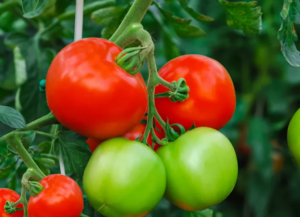Growing tomatoes is often the impetus for starting a vegetable garden, and every tomato lover dreams of growing the ultimate tomato: firm but juicy, sweet but tangy, aromatic, and blemish free.
Unfortunately, there are few vegetables that are prone to more problems than tomatoes. The trick to growing great-tasting tomatoes is to choose the best varieties, start the plants off right, and control problems before they happen. Start here with some time-tested tomato growing tips to ensure your tomato bragging rights this year.
1. Preheat the garden soil. Tomatoes love heat. They won’t really start to grow until both the soil and air temperatures remain warm. You can speed things up in the soil by covering the planting area with black or red plastic a couple of weeks before you intend to plant. Those extra degrees of soil warmth will translate into earlier tomatoes.
You can lift the plastic before you plant, but some research contends that red plastic mulch has the added benefit of increasing your tomato yield.
2. Bury the stems. Plant your tomato plants deeper than they come in the pot, all the way up to the top few leaves. When planted this way, tomatoes are able to develop roots all along their stems. And more roots make for a stronger plant.
You can either dig a deep hole or simply dig a shallow trench and lay the plant sideways. It will quickly straighten itself up and grow toward the sun. Just be careful not to drive your tomato stake or cage into the buried stem.
3. Mulch tomatoes after the soil has warmed. If you are not going to leave plastic on the soil, hold off on putting down mulch until after the ground has had a chance to warm up. Although mulching conserves water and prevents the soil and soilborne diseases from splashing up on the plants, if you put it down too early, it will also shade and cool the soil. Because tomatoes love heat, allow the sun to warm the soil in the spring. After temperatures remain warm, both during the day and at night, you can add a layer of mulch to retain moisture.
4. Remove the bottom leaves. After your tomato plants reach about 3 feet tall, remove the leaves from the bottom foot of the stem. These are the oldest leaves, and they are usually the first leaves to develop fungus problems. As the plants fill out, the bottom leaves get the least amount of sun and airflow. Because these leaves sit close to the ground, soilborne pathogens can easily splash up onto them. Removing them helps prevent fungal diseases from taking hold. Spraying weekly with compost tea also seems to be effective at warding off fungal diseases.
5. Pinch and prune for more tomatoes. Pinch and remove suckers that develop in the crotch joint of two branches. They won’t bear fruit and will take energy away from the rest of the plant.
However, go easy on pruning the rest of the plant. You can thin out a few leaves to allow the sun to reach the ripening fruit, but it’s the leaves that are photosynthesizing and creating the sugars that give flavor to your tomatoes. Fewer leaves will mean fewer sweet tomatoes.
6. Water regulary. Water deeply and regularly while the fruits are developing. Irregular watering—missing a week and trying to make up for it—leads to blossom end rot (a calcium deficiency) and cracking and splitting. The rule of thumb is to ensure your plants get at least 1 inch of water per week, but during hot, dry spells, they may need more. If your plants start to look wilted for most of the day, give them a drink.
After the fruit begins to ripen, you can ease up on the watering. Lessening the water will coax the plant into concentrating its sugars, for better flavor. Use your judgment. Don’t withhold water so much that the plants continually wilt and become stressed or they will drop their blossoms and possibly their fruit.
7. Getting your tomatoe plants to set tomatoes. Tomatoes’ ripening is pretty much at the mercy of the weather, but sometimes we can help things along. Pinching off the tips of the main stems in early summer will encourage indeterminate tomatoes (those with fruit available continuously) to start putting their energy into flowering.
Indeterminate tomatoes like to grow tall before they start setting fruits, so don’t be alarmed if your tomato plants aren’t flowering for their first month or two. Pinching is also a handy trick toward the end of the summer when you want the last tomatoes to hurry up and ripen.
It shouldn’t be a problem getting determinate tomatoes (those that ripen all at once) to set fruit unless weather conditions are unfavorable and cause a condition aptly named “blossom drop.”





